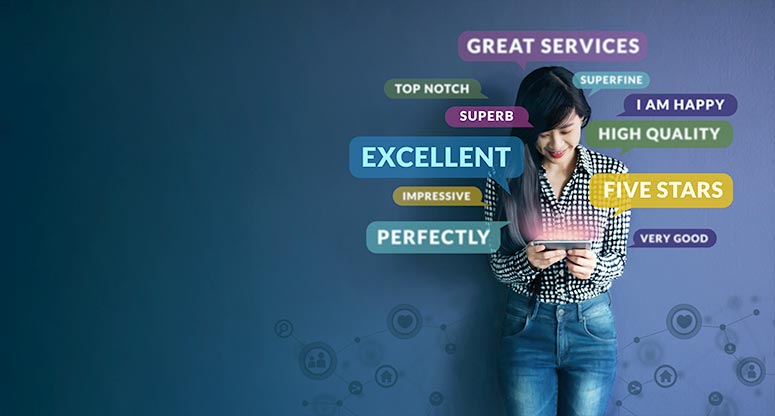Operations5-minute read
Why Your Business Needs an Omnichannel, Customer-service Strategy
In today’s tech-focused world, great customer care requires interacting with people on a wide variety of communications channels. And that’s just the beginning: According to research from Salesforce, today’s consumers also expect a seamless, integrated experience across all of those channels—and more than half of them (55%) feel that businesses are failing to offer it.
Businesses can meet this demand by developing an omnichannel, customer-service strategy. The process of integrating all of your customer touchpoints into a consistent, user-friendly experience, omnichannel customer service should be a priority for any company.
And that’s a good thing. Omnichannel customer service is a win-win. By giving customers an easier, more responsive way to interact with your business, you’re nurturing satisfaction and loyalty, which translates into increased customer retention, a key driver of sales and growth.
Don’t forget. There’s a difference between multichannel and omnichannel customer service. The former simply means that you’re communicating with customers across a variety of channels; the latter means you’re integrating everything into a seamless, user-friendly whole. Read more about the difference between multichannel and omnichannel here.
The Omnichannel Customer Journey
Having a customer’s journey is paramount to make sure customers are satisfied.
Source: www.shutterstock.com.
How exactly does an omnichannel strategy help support that all-important customer satisfaction metric? It’s all about convenience and ease of use.
Imagine that a customer is browsing your website for information, and suddenly has a question about something he sees there (or something he doesn’t). His first step is probably to look for an answer via your automated chat feature. Since it’s built into your website, the chatbot should usually be able to anticipate the question that will be asked, based simply on the customer’s actions in the current session.
But if the customer doesn’t get the information he wants via that chatbot, the next step—calling or texting a live agent—should be easy and almost instantaneous. What’s more, that agent should be fully aware of what the customer is inquiring about, as well as the details of the current session. And if the customer has a past history with your company, that data should be instantly available to the agent, too.
The upshot is that, at every step of this process—from when a question first occurs to a customer to the point when it’s answered—he’s had a seamless experience without the need to explain anything a second time or, worse, start over from the beginning. At each point of transition, your customers are continuing where they left off, in a process that feels completely seamless, natural and hassle free.
It’s natural enough to expect that kind of seamlessness from your website to your customer care center. But with a truly omnichannel strategy, it should also extend to other, slightly more peripheral channels, such as email support or your Facebook page. And every step of the way, the support customers receive on all of these channels should reflect the highest possible quality of service and responsiveness.
Read more: about the important of consistency in your customer service strategy.
What Omnichannel Customer Service Means for Your Business

If done correctly, omnichannel customer service should feel completely natural to your customers.
Source: www.shutterstock.com.
If done correctly, omnichannel customer service should feel completely natural to your customers. The idea is to promote ease of use—they’ll have no idea just how complex the omnichannel process is for your business.
And make no mistake, the process of implementing omnichannel customer service is complex. The number of communications channels used by today’s customers is constantly increasing. The variety of tools and level of expertise needed to provide top-notch customer care for each—and the effort needed to integrate them all into one, cohesive package—is no small matter.
For online-only businesses, it requires the careful integration of messaging across websites, social media, email and other applicable channels. It also requires making sure the service reps who speak to the people who contact you have instant access to each customer’s entire history with your business.
Brick-and-mortar businesses have another layer of complexity to offering omnichannel customer service. They must make the additional effort to integrate their in-store experiences with the electronic-based communications that customers receive. That means equipping on-the-floor personnel with the same instant access to customer history that your call center agents have.
This complexity has been simplified somewhat by advanced customer relationship (CRM) software, which has evolved by leaps and bounds in recent years to meet the increasing demand for omnichannel customer service.
Because it puts essential customer information into one accessible database, CRM software can go far toward helping your business integrate your info and processes into a seamless and efficient whole. Yet integrating the software into your existing processes and training your personnel in its use can be a complex undertaking in and of itself.
Trust Your Omnichannel Customer Service Strategy to the Experts
Achieving truly omnichannel customer service requires syncing an enormous number of important components—from a sophisticated and scalable website to a proactive and customer-centric social media strategy and from coordinated email marketing campaigns to the smart application of CRM software.
The complexity of the challenge, combines:
- The need for advanced technological expertise to carry it out.
- And the need to get it all done as quickly as possible to avoid alienating increasingly demanding customers.
This combination has led many business leaders to conclude the best way to implement omnichannel customer service is to outsource the service to a customer care specialist.
Partnering with an on-demand contact center solutions provider gives you instant access to real experts who know how to combine all of your customer care elements into a unified strategy. What’s more, it also eliminates the need for you to maintain your own call center, hire and manage high-quality agents—plus purchase and manage the hardware and software to make it all run.
Based in the United States for 20+ years of operation, Working Solutions has specialized in providing customer care for longer than many of today’s best-known companies have existed. Its success is illustrated by the elite list of clients, ranging from modest startups to Fortune 100 companies.
We’re constantly evolving to keep up with a rapidly changing market, offering the technological expertise, communications best practices and attention to security you need to deliver great sales and service.
Learn more about how we can help you achieve omnichannel customer superiority: Contact us here for your complimentary consultation.
Contact us today.
This Might Interest You...
This website uses cookies to personalize and improve your experience. Continue browsing our site if you agree to our Cookie Policy or feel free to Manage Cookies yourself.


